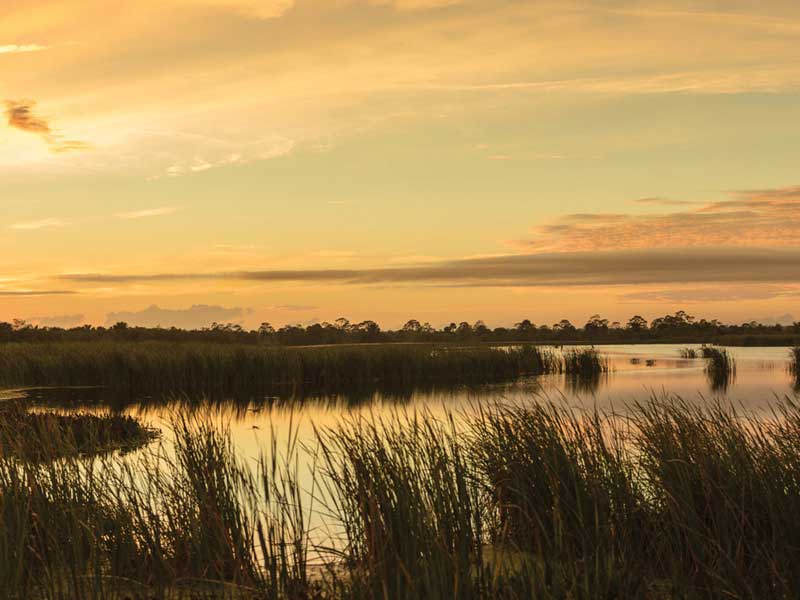by TERESA SCHIFFER
By now, you’ve probably heard of the crisis off Florida’s coasts. Sea turtles, manatees, and other wildlife are dying off in record numbers, victims of huge blooms of toxic blue-green algae and red tide. People are outraged at the state of our waters, as it’s not only an ecological disaster, but an economic disaster as well, as beaches are closed and tourists discover they can’t enjoy the fishing or swimming that’s so popular here.
So what’s causing these massive algal blooms that are wreaking such havoc in Florida’s waters? While red tide is a naturally occurring phenomenon with several contributing factors, it can be exacerbated by coastal pollution such as sewage and agricultural runoff. Red tide occurs in the Gulf and ocean waters, whereas the blue-green algae is found in freshwaters, such as lakes and ponds. Nutrient pollution is a major cause of the blue-green algae blooms.
The need for fertilizers in the fields is not going away anytime soon, so it’s imperative that we find a way to neutralize these chemicals in order to protect our waters. That’s where the Everglades Foundation comes in. The Foundation has organized a competition to encourage innovation in cleaning up bodies of water around the world. The goal is to find a cost-effective way to remove phosphorus from water in virtually any environment. The George Barley Water Prize has been established to reward the efforts of those scientists and companies who are able to tackle this growing problem of algae and phosphorus in our water.
Phosphorous is one of the main ingredients in fertilizer because in nature it’s a limiting factor. Plants need phosphorus to grow, and there is only so much available in the environment, so plants will only grow as much as they can, based on how much phosphorus they can access. Adding additional phosphorous allows plants to grow bigger and be more productive. Unfortunately, phosphorous can’t distinguish between “good” plants and “bad” plants, so the runoff from farms leads to displaced phosphorous that winds up feeding harmful algae in our waters.
The George Barley Water Prize is sponsored in part by the Scotts Miracle-Gro Foundation. A grand prize of $10 million will go to the team who is most successful with their design. This is an incredible opportunity for researchers to test their ideas in real-world applications with the chance to win an unprecedented prize. According to Melodie Naja, Chief Scientist for the Everglades Foundation, this competition seeks to solve the problem of clean water for ourselves and future generations.
The competition was first conceived of about five years ago. The board of directors for the Everglades Foundation was very concerned about nutrient pollution in Lake Okeechobee. Their research indicated that it would cost the state about $12 billion to clean Lake Okeechobee. This astronomical figure was clearly out of reach, but they still needed a solution. The idea arose to incentivize a project to find new, more efficient ways of removing phosphorus from water.
An outside company was then brought in to design a contest and prize for the Foundation to promote. International experts came and learned about what the issues were surrounding the lake clean-up, and the best way to get the involvement of highly talented researchers.
Dr. Naja describes what the competition aims to accomplish, “We are addressing one of the main parameters driving the algae bloom, phosphorus. Basically, the main purpose of the prize is to find cost-effective technology that would scale up, and the performance would not drop when scaled up, that can be operated anywhere in the world under different conditions, under different temperatures, in cold climates and warm climates. It needs to perform well under different flows, different volumes of water, and different phosphorus concentrations.”
This technology is focused on freshwater contamination, so will mainly reduce the occurrence of toxic blue-green algae. This type of algae is actually cyanobacteria, and while it’s naturally present in most lakes and freshwater sources, harmful blooms can make the water dangerous to drink, swim in, or play in. Effectively removing phosphorus pollution would greatly reduce the incidence of harmful algal blooms (HABs).
The problem of HABs isn’t specific to Florida, either. From the Everglades to Lake Erie, Canada to China, and more, water systems around the world are being negatively impacted by excessive algae. Throughout the United States, every state has been affected. These algae blooms make water unusable for most purposes, costing the U.S. up to $2 billion each year.
The George Barley Water Prize competition involves testing the teams’ technologies in different environments throughout various stages of the competition. Ten teams were taken to Canada to test their designs and functionality. They tested on various volumes of water at Holland Marsh, a tributary of Lake Simcoe in Ontario. Nine teams were able to complete their testing, and their results are being analyzed to determine who will move on to the next final round.
The next stage involves the four finalists to test their technologies in Florida, in the area of Lake Jessup in Seminole County. They will conduct these tests for 14 months, starting in May, 2020. Doing the testing in these different areas allows experts to determine if the treatments will be effective in different parts of the world. Though the results of these tests won’t be available for at least three years, it is promising to know that individuals and scientists from around the world are working together (though against each other) to tackle the world’s phosphorus and algae problems now.


